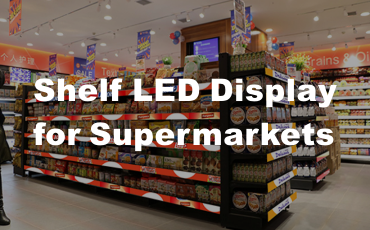The world of indoor LED display technology is undergoing a remarkable transformation. As we move into 2025, the industry is not just growing; it’s evolving at an unprecedented pace. Driven by significant technological innovation, the global market size for these displays continues to expand, finding new applications in commercial, public, and creative spaces.
This evolution is marked by a dual focus: delivering breathtaking visual quality while championing sustainability and energy efficiency. Are you ready to see what the future of indoor displays holds?
Understanding Indoor LED Display Technology in 2025
The core of LED display technology in 2025 revolves around creating more immersive and efficient visual experiences.
Key trends are shaping the display market, including the push for finer pixel density, which results in sharper, clearer images even at close viewing distances.
This allows for high-brightness applications without compromising on detail.
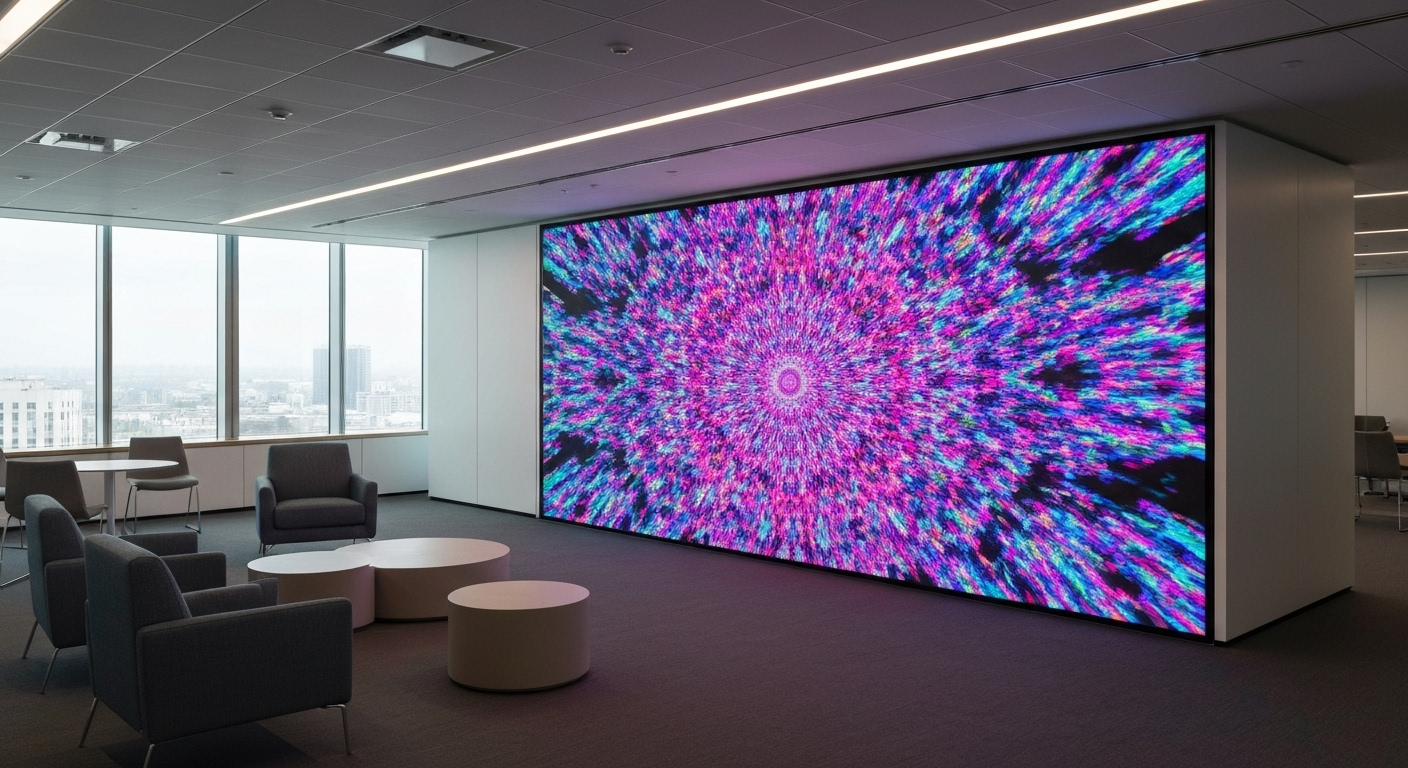
Simultaneously, there is a major industry-wide effort to reduce energy consumption. Manufacturers are developing innovative solutions that lower power usage and operational costs, making advanced LED displays more accessible and sustainable for a wider range of indoor environments.
These trends signal a mature market that values both performance and responsibility.
Evolution of Indoor LED Displays
The journey of indoor LED displays has been one of constant technological innovation. We’ve moved from basic single-color signs to sophisticated, high-definition video walls capable of displaying dynamic content in real time.
This progress is largely thanks to the development of smaller, more powerful light-emitting diodes.
A significant leap forward comes from Mini-LED and Micro-LED technologies. These innovations allow for an incredible number of individual pixels to be packed into a smaller area, leading to a dramatic increase in pixel density and much higher resolution.
The result is a crisper, more detailed image that was previously unattainable. According to a research report by TrendForce, the Micro-LED market is accelerating toward commercialization in high-end applications. [1]
This evolution is not just about better picture quality. It also enables new form factors and applications.
Thinner, lighter, and even flexible screens are becoming more common, opening up creative possibilities for architects, event producers, and retailers who want to create truly unique and engaging indoor spaces.
Key Components and How They Work
An indoor LED screen is a complex system of interconnected components working in harmony. At the heart of the display are the LED modules, which contain thousands of individual light-emitting diodes grouped into pixels.
The distance between these pixels, known as pixel pitch, is a critical factor determining the screen’s resolution and optimal viewing distance.
Beyond the modules, several other parts are essential for an LED display solution to function correctly. These core components include:
- Power Supplies: These convert AC power from the wall outlet into the DC voltage required by the LED modules.
- Receiving and Sending Cards: This hardware processes the video signal and distributes it to the correct modules across the screen.
- Control Systems: This is the software and hardware you use to manage content, adjust settings like brightness, and schedule playlists.
Effective integration of these components not only ensures a high-quality image but also impacts long-term reliability and maintenance costs. Modern systems are designed for easier serviceability, often featuring front-access modules that simplify repairs and reduce downtime.
Major Trends Shaping Indoor LED Displays for 2025
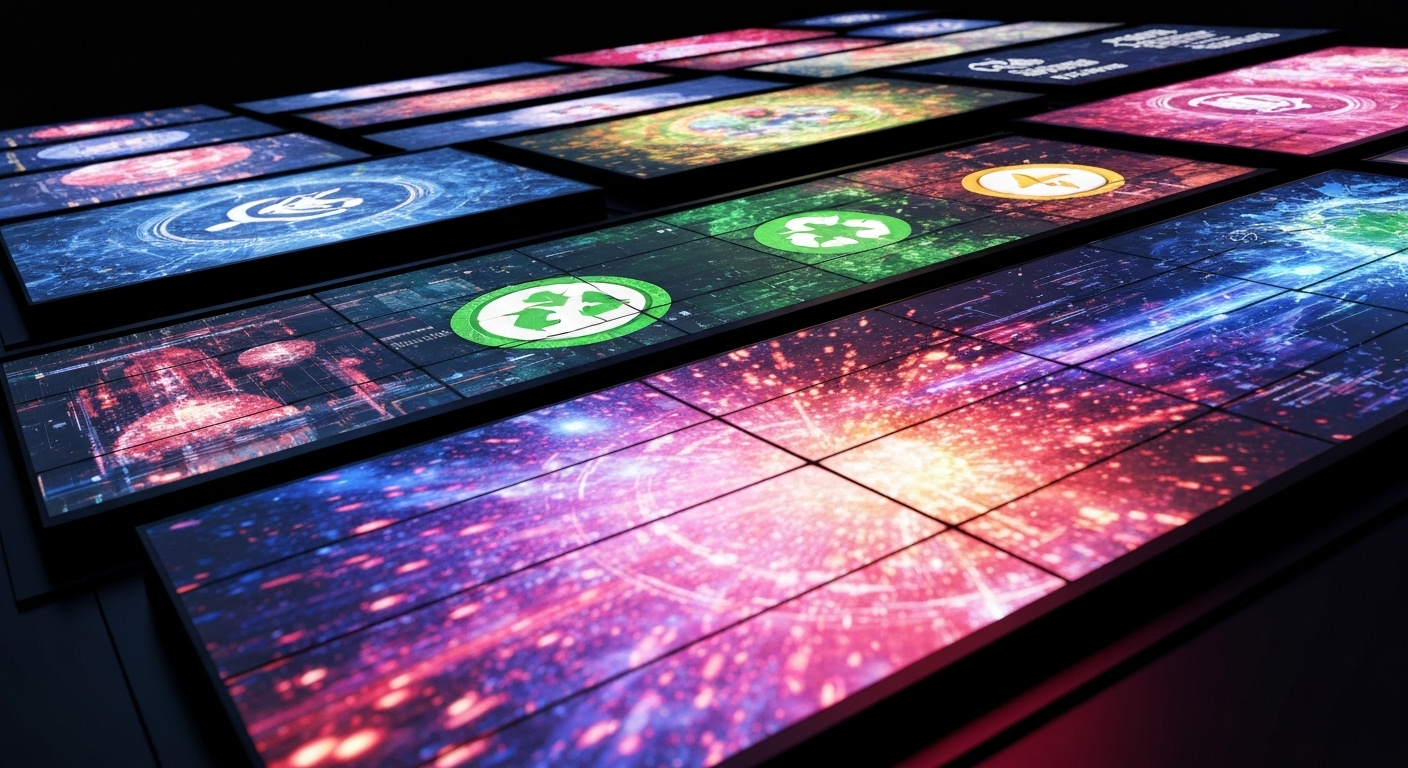
As we look toward 2025, the indoor LED display landscape is being defined by two powerful, parallel trends. First, market demand is surging for screens with a high refresh rate, ensuring ultra-smooth playback for fast-moving video content, which is crucial in broadcasting and high-end advertising.
At the same time, the display industry is placing an unprecedented emphasis on reducing energy consumption.
This focus is driven by both environmental concerns and the practical need to lower operating costs for large-scale installations.
These trends are pushing manufacturers to innovate in ways that enhance user experience while promoting sustainability.
The Rise of High Refresh Rate Screens
High refresh rate technology is no longer a niche feature; it’s rapidly becoming a standard for high-quality indoor LED displays.
The refresh rate, measured in Hertz (Hz), indicates how many times per second the image on the screen is updated. A higher number results in smoother, more fluid motion, which is essential for certain applications.
This feature significantly improves the perceived image quality, eliminating flicker and motion blur that can be distracting or cause eye strain.
For environments where clarity is paramount, a high refresh rate is non-negotiable. Key applications benefiting from this technology include:
- Broadcast Studios: Prevents scan lines from appearing when a screen is filmed by a camera.
- Control Rooms: Ensures real-time data and video feeds are displayed without lag or stutter.
- Virtual Production: Creates seamless, realistic backdrops for film and television.
The demand for large video wall installations with flawless motion handling has cemented the importance of high refresh rates.
As content becomes more dynamic and interactive, this trend will only continue to grow, making it a critical specification for anyone investing in a new LED display.
Focus on Energy-Saving and Sustainability
Sustainability has become a central theme in the evolution of indoor LED technology.
Manufacturers are actively developing solutions that prioritize energy efficiency, responding to both regulatory pressures and customer demand for greener products.
This focus translates into displays with significantly low power consumption compared to older models.
One of the key innovations is the use of more efficient LED chips and advanced driver ICs that minimize wasted energy. Improved heat dissipation is another critical aspect.
Better thermal management not only reduces the need for power-hungry cooling systems but also extends the lifespan of the display components, contributing to less electronic waste.
This push for sustainability benefits everyone. For your business, it means lower electricity bills and a reduced carbon footprint.
For the planet, it means conserving resources and minimizing environmental impact. As we move forward, a product’s energy efficiency rating will be just as important as its resolution or brightness.
Advances in Display Performance
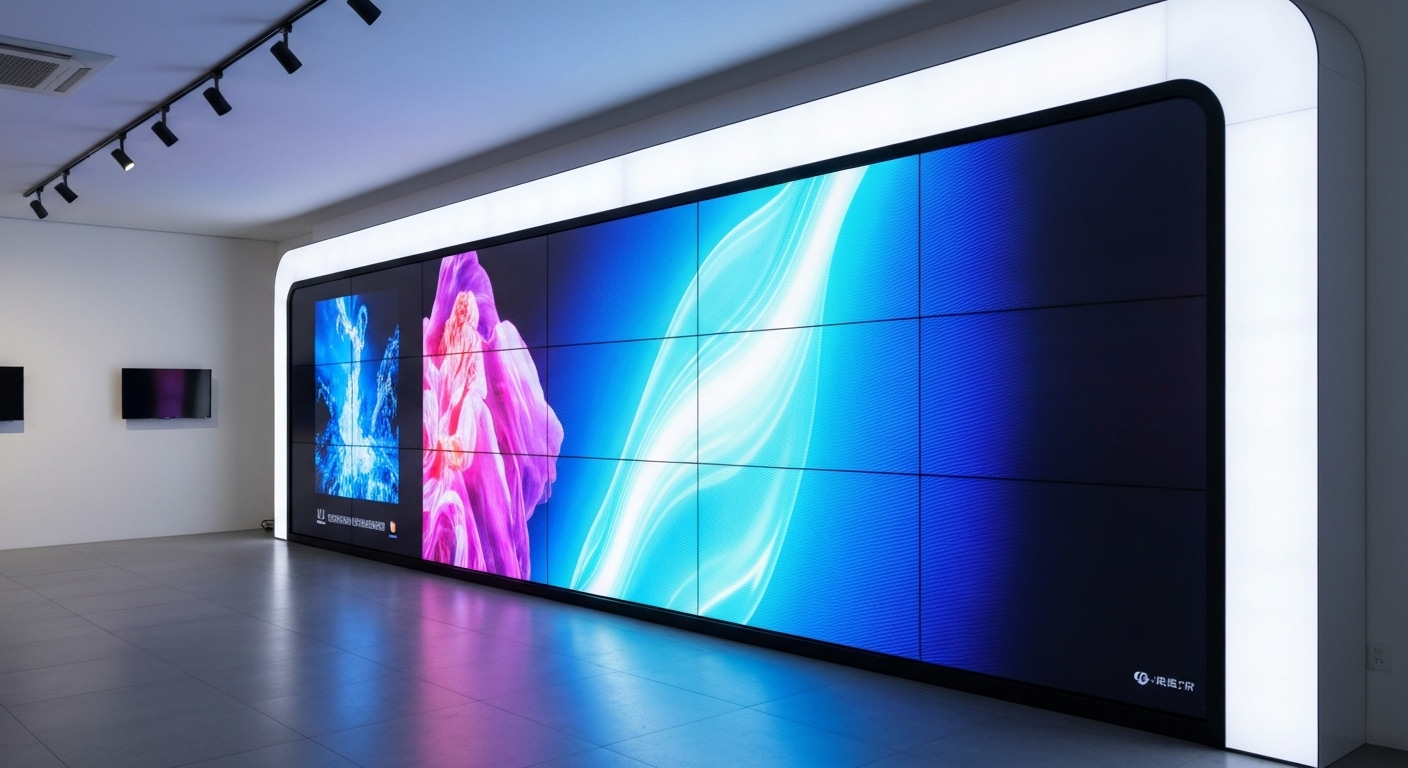
The relentless advancement of display technology is pushing the boundaries of what’s possible with indoor LEDs. In 2025, the conversation is centered on perfecting the visual experience.
This means achieving unparalleled picture quality through a combination of high definition, exceptional color accuracy, and optimized brightness levels.
These improvements are not just incremental; they represent a significant leap in performance.
The goal is to create displays that can reproduce content with lifelike vibrancy and clarity, making them more engaging and effective in any setting. Let’s examine how these enhancements are being achieved.
How High Refresh Rates Improve Viewing Experience
A high refresh rate directly translates to a superior viewing experience by creating smoother and more realistic motion.
When a display screen updates its image more frequently, the human eye perceives fast-moving content without the jarring blur or stutter seen on lower-spec screens. This is particularly noticeable in real-time video feeds and dynamic advertisements.
This improvement in motion clarity elevates the overall image quality. For commercial displays in high-traffic areas, this means your message is delivered clearly and professionally, capturing attention without visual distractions.
The absence of flicker, a common issue with low-refresh-rate screens, also reduces eye fatigue for those viewing the display for extended periods.
Essentially, a high refresh capability ensures that the display screen can keep up with the demands of modern high-definition content.
Whether it’s for a live sports broadcast, a corporate presentation, or an immersive art installation, the fluidity provided by a high refresh rate makes the visual experience more engaging and comfortable for the audience.
Enhancements in Color Accuracy and Brightness
Achieving true-to-life visuals depends heavily on color accuracy and brightness. In 2025, indoor LED displays are making significant strides in both areas, delivering stunningly vibrant and realistic images.
Advanced calibration technologies now allow for a wider color gamut, ensuring that brand colors and artistic content are reproduced exactly as intended.
High brightness is another critical feature, especially for displays in well-lit environments like shopping malls or airport terminals. However, modern displays offer more than just raw power; they provide intelligent control over brightness levels. Key enhancements include:
- Wider Dynamic Range: Enables deeper blacks and brighter whites in the same scene.
- Greater Color Depth: Allows for smoother gradients and more subtle shades.
- Advanced Calibration: Ensures color uniformity across the entire display.
These improvements, combined with higher pixel density, create powerful visual experiences. The ability to produce brilliant images that remain color-accurate under various lighting conditions makes today’s indoor LEDs more versatile and impactful than ever before.
Breakthroughs in Energy Efficiency
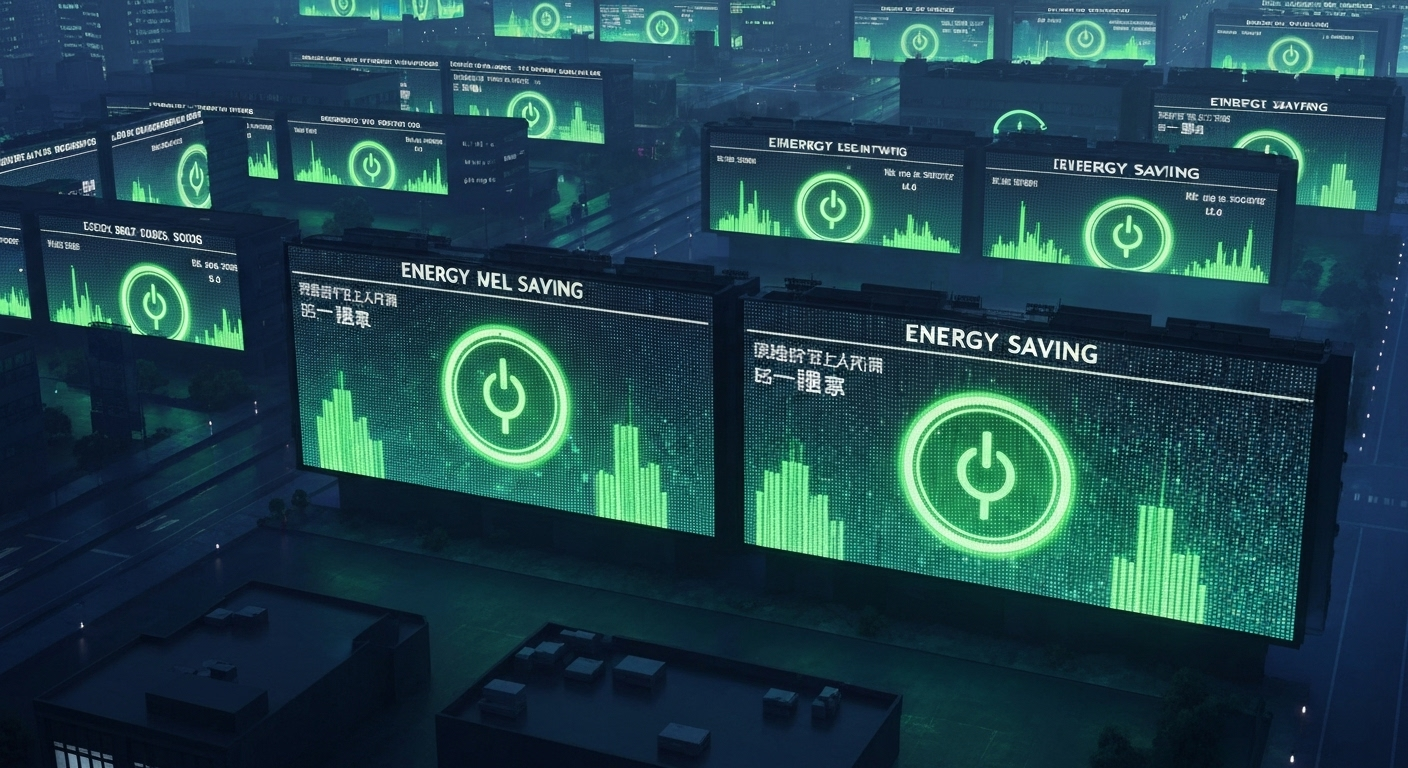
A major breakthrough in the indoor LED display industry is the significant progress in energy efficiency.
Reducing power consumption is no longer an afterthought but a primary design goal. This shift is driven by a commitment to sustainability and the practical need to lower long-term operational costs for users.
New energy-saving technology and advanced power management systems are at the forefront of this movement.
These innovations are fundamentally changing how displays operate, minimizing wasted energy without sacrificing visual performance. Let’s look at the specific technologies making this possible.
New Energy-Saving Technologies in 2025
The latest market trends reveal a strong push toward innovative, energy-saving designs in indoor LED displays. One of the primary technologies gaining traction is the use of common cathode LED configurations.
Unlike traditional common anode designs, this approach delivers power to the red, green, and blue diodes separately, significantly reducing overall power consumption and heat generation.
This focus on efficiency results in a display solution with remarkably low power consumption. By generating less heat, these displays require less intensive cooling, further cutting down on energy use. Improved heat dissipation also helps prolong the lifespan of the electronic components, enhancing the reliability and value of the investment.
These energy-saving features are becoming a key selling point. As businesses become more environmentally conscious, choosing a display solution that aligns with sustainability goals is crucial. The ability to deliver stunning visuals while keeping energy costs down represents a major step forward for the industry.
Impact of Advanced Power Management Systems
Advanced power management systems are playing a crucial role in boosting the sustainability of modern indoor LED displays.
These intelligent control systems go beyond simple on/off functions to dynamically optimize energy use based on real-time conditions. This smart approach ensures the display screen operates at peak efficiency at all times.
These systems offer features that actively reduce energy waste and can lower long-term maintenance costs. Key functionalities often include:
- Dynamic Brightness Adjustment: Automatically lowers brightness during off-peak hours or in darker ambient light conditions.
- Scheduled Power States: Allows you to program the display to enter a low-power standby mode when not in use.
- Component-Level Monitoring: Provides data on power draw, helping identify inefficiencies or potential hardware issues early.
By integrating such intelligent power management, you gain precise control over your display’s energy footprint. This not only supports sustainability initiatives but also translates into tangible savings on your electricity bill, making advanced LED technology a smarter and more responsible choice.
Fine Pitch LED Displays: What’s New and Why It Matters
Fine pitch LED technology is revolutionizing indoor display applications. Characterized by a very small pixel pitch—the distance between the centers of adjacent pixels—these displays deliver exceptionally high resolution. This allows for clear, sharp images even when viewed from just a few feet away, something traditional indoor LED screens struggled with.
This capability for higher resolution opens up a host of new application scenarios that were previously dominated by LCD technology. The growing adoption of fine pitch LED displays signals a major shift in how businesses and organizations approach indoor visual communication. Let’s explore the specific benefits and applications driving this trend.
Benefits of Fine Pitch LEDs for Indoor Spaces
The primary advantage of fine pitch LED displays is their ability to create seamless, high-resolution images at close viewing distances.
Thanks to their high pixel density, they eliminate the visible grid-like structure seen on larger pitch screens, resulting in a smooth, picture-perfect image similar to a high-definition television.
This creates immersive visual experiences that are perfect for environments where the audience is near the screen. The benefits are clear across various indoor settings:
- Sharper Details: Intricate graphics, small text, and detailed video content are rendered with exceptional clarity.
- Seamless Video Walls: Modules fit together without any visible bezels or seams, creating one large, continuous image.
- Superior Image Quality: Offers outstanding brightness, contrast, and color reproduction compared to many other display types.
Whether in a corporate conference room, a high-end retail store, or a broadcast studio, fine pitch LEDs elevate the quality of visual communication. They provide the detail and polish needed for professional presentations, compelling advertisements, and engaging information displays.
Applications Driving Demand for Fine Pitch in 2025
The unique benefits of fine pitch technology are driving its adoption across a wide range of demanding applications. In mission-critical environments like control rooms, the ability to display vast amounts of detailed data on a single, seamless video wall is essential for monitoring and decision-making.
In public spaces such as airports and shopping malls, fine pitch displays are replacing traditional digital signage. Their high brightness and clarity ensure that advertisements and information are easily visible, even in brightly lit atriums. They create a modern, high-tech ambiance that enhances the visitor experience.
Furthermore, the rise of virtual production in the film and broadcast industries has created a massive demand for fine pitch LED video walls.
These screens serve as realistic, dynamic backdrops, replacing traditional green screens and allowing actors to interact with the virtual environment in real time, dramatically improving filming efficiency.
Market Insights: Indoor LED Displays in the United States, Europe, and Japan

The global LED display market is not monolithic; different regions exhibit unique characteristics and growth patterns.
The markets in the United States, Europe, and Japan are among the most mature, each with distinct demands and leading players. Understanding these regional nuances is key to grasping the global landscape.
While all three regions value high-quality and technologically advanced products, their application focus, competitive environment, and growth rate can vary. Let’s examine the dynamics shaping these key markets and the factors driving their growth.
Regional Market Dynamics and Growth Factors
The market trends in North America, Europe, and Japan reflect mature economies with strong demand for high-performance LED displays.
The global market size has shown steady growth, with a Frost & Sullivan report from 2023 projecting continued expansion.[2] While specific annual growth rate figures vary, the overall trajectory is positive.
Market demand in these regions is driven by different factors. The U.S. market sees strong demand from sports venues and large-scale commercial displays. Europe focuses on transportation and security applications, while Japan has a high requirement for refined public displays and stage rentals.
These differences highlight the varied priorities within each market. The table below summarizes the key characteristics based on available market analysis.
| Region | Key Characteristics | Main Applications | Leading Companies |
|---|---|---|---|
| North America | Technologically advanced with strong demand | Commercial displays, sports venues, stage rentals | Daktronics, Planar, Samsung |
| Europe | Stable growth with a focus on quality and performance | Commercial displays, transportation, security | Barco, Lighthouse, Sony |
| Japan | Technologically mature with a demand for refinement | Commercial displays, stage rentals, public displays | Panasonic, Sony, NEC |
Key Differences Between U.S., European, and Japanese Markets
Beyond market size and growth, the U.S., European, and Japanese display markets show distinct differences in their structure and priorities.
The supply chain in each region is influenced by local manufacturing capabilities and relationships with global suppliers, with many top brands like Samsung and Barco holding a significant market share in the high-end segment.
The preferred application scenarios also diverge. The U.S. market is a leader in large-venue entertainment and sports, driving demand for massive, high-impact displays. In contrast, Japan’s market often prioritizes ultra-high-resolution displays for public information and intricate commercial advertising where detail and refinement are paramount.
Europe strikes a balance, with strong demand in corporate, retail, and public sector applications.
These differences create a varied competitive landscape. While some global brands are strong across all three regions, local and regional players often carve out a niche by catering to specific needs.
For example, Daktronics is a dominant force in American sports venues, while European companies often excel in customized visualization solutions.
Next-Generation Features to Watch in Indoor LEDs
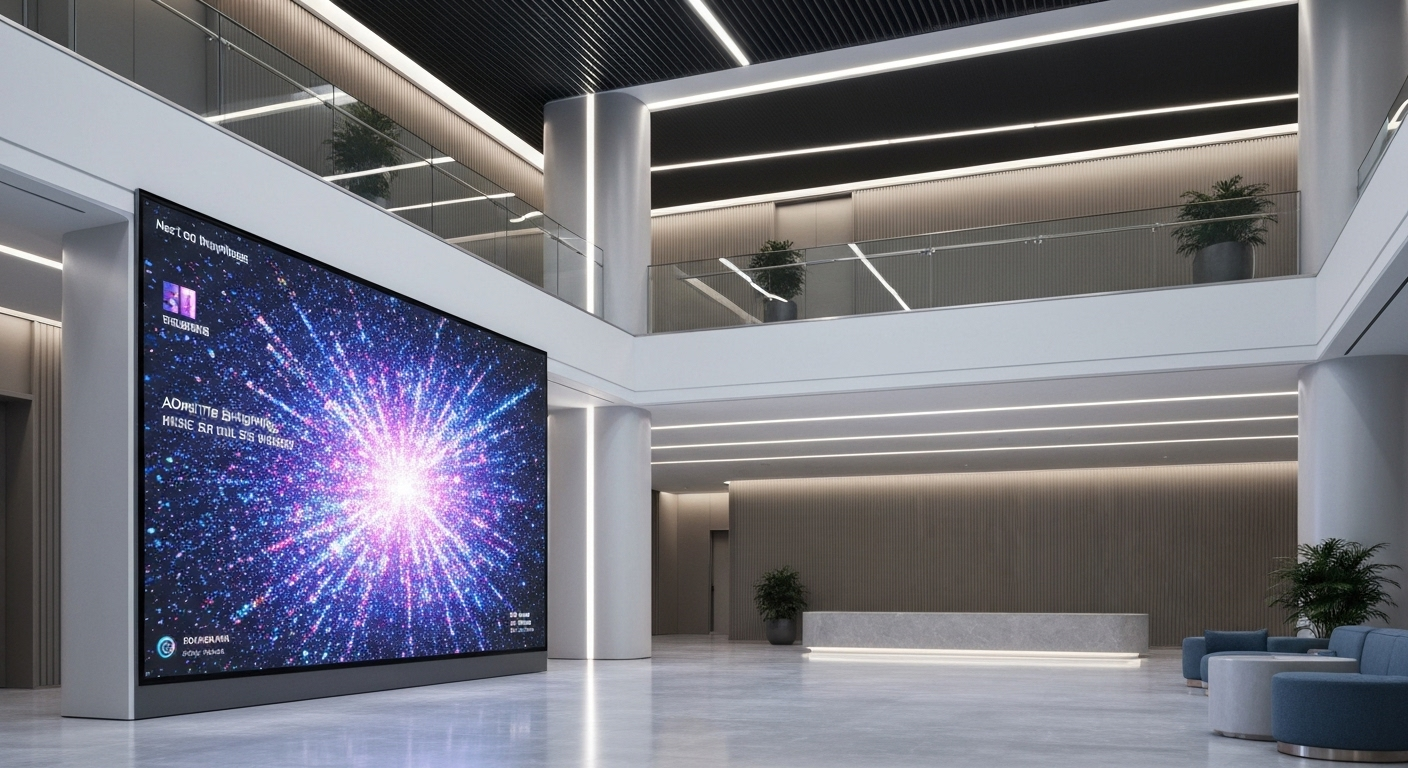
The future of indoor LED displays is intelligent and integrated. Next-gen features are moving beyond simple visual output to create smarter, more responsive systems.
Expect to see high-brightness displays equipped with adaptive brightness controls that automatically adjust to ambient lighting, ensuring optimal visibility and energy efficiency.
This evolution is also about connectivity. The integration of LED displays with smart building technologies is set to transform how we manage and interact with our environments, paving the way for their role in smart cities. Let’s explore these cutting-edge capabilities in more detail.
High-Brightness and Adaptive Brightness Control
High-brightness capabilities are essential for indoor LEDs placed in areas with significant ambient light, such as atriums or window-facing installations. However, maximum brightness isn’t always needed. The next generation of displays incorporates adaptive brightness control, an intelligent feature that uses sensors to automatically adjust illumination levels based on the surrounding environment.
This smart brightness control offers several key advantages for any high-definition display solution. It ensures the screen is always perfectly visible without being overpowering, improving the viewing experience and reducing eye strain. The benefits are clear:
- Optimal Visibility: The screen remains clear and vibrant whether in bright daylight or a dimly lit room.
- Energy Savings: The display consumes only the power necessary for the current lighting conditions.
- Longer Lifespan: Reducing unnecessary brightness levels helps minimize component wear over time.
This technology makes the display solution more versatile and efficient. It represents a shift from static hardware to a dynamic system that intelligently responds to its environment, delivering better performance and lower operating costs.
Integration with Smart Building Technologies
The concept of a smart building extends to its communication systems, and indoor LED displays are becoming a key component. Through smart integration, digital signage can now connect with other building control systems, such as lighting, security, and HVAC, to create a truly connected and responsive environment.
Imagine a scenario where an emergency alert triggered by the security system automatically displays evacuation routes on all LED screens throughout the building. This level of integration transforms a simple display into a vital part of the building’s operational and safety infrastructure. This connectivity is a foundational element for the development of smart cities.
This trend moves beyond displaying pre-programmed content. It enables LED displays to become dynamic information hubs that react to real-time data from various building sensors and systems. This smart integration unlocks new possibilities for facility management, corporate communication, and public safety.
Choosing an Indoor LED Display in 2025: A Beginner’s Guide
Selecting the right indoor LED display can feel overwhelming given the array of options available. This beginner’s guide is here to simplify the process.
Choosing the perfect display solution involves more than just looking at the price tag; it requires a clear understanding of your needs and the key specifications that will meet them.
To make an informed decision, you’ll need to consider factors ranging from the physical space to the type of content you plan to show. Paying attention to important specifications and industry certifications will ensure you invest in a reliable, high-performing display.
Essential Equipment and Resources Needed
Purchasing an indoor LED display screen is just the first step. To ensure a successful project, you need to account for the essential equipment and resources required for its operation and upkeep.
A complete setup goes beyond the display panels themselves and includes a support structure, power infrastructure, and a content management system.
Before committing, consider the full scope of the project. You will need:
- Mounting Hardware: A sturdy frame or structure to safely support the weight of the display.
- Control System: The hardware and software needed to send your content to the screen.
- Sufficient Power and Data Cabling: Professional installation requires proper wiring to ensure safety and reliability.
Thinking about these resources from the start helps you budget accurately and avoid unexpected hurdles during installation. Factoring in potential maintenance costs is also wise, as even the most reliable screens may require service over their lifespan. Planning ahead ensures a smoother process from purchase to daily operation.
Important Specifications and Certifications to Consider
When evaluating an indoor LED display screen, specific technical details will determine its performance.
Pixel pitch is one of the most critical specifications, as it directly influences the display’s resolution and ideal viewing distance. A smaller pixel pitch is necessary for up-close viewing, while a larger pitch may suffice for screens viewed from afar.
Resolution, brightness, and refresh rate are equally important. Ensure the display’s native resolution is suitable for your content, and its brightness is adequate for your indoor lighting conditions. As market demand for high-quality video continues to grow, a high refresh rate is crucial for smooth, flicker-free motion.
Finally, look for key industry certifications like CE, FCC, and RoHS. These certifications indicate that the display screen meets international standards for safety, electromagnetic interference, and the restriction of hazardous materials.
They provide an assurance of quality and compliance, protecting your investment and ensuring safe operation.
Step-by-Step Guide: How to Select and Set Up an Indoor LED Display
This step-by-step guide will walk you through the entire process of choosing and implementing an indoor LED display.
The selection process requires careful thought to ensure the final installation meets your expectations and delivers a strong return on investment. From defining your goals to planning for maintenance, each step is crucial.
By following this structured approach, you can confidently navigate the complexities of purchasing an LED display screen. You will be better equipped to evaluate your options and manage the installation for a successful outcome.
Step 1: Define Your Display Requirements and Intended Use
The first and most important step in selecting an indoor LED display is to clearly define its purpose. What do you want to achieve with your screen?
Your intended use will guide every subsequent decision, from the technical specifications to the budget. Are you looking to display dynamic advertising, present detailed corporate data, or create an immersive artistic experience?
Consider the specific application scenarios. A display for a corporate boardroom has very different requirements than one for a retail storefront or a house of worship.
For a boardroom, clarity for text and graphics at close proximity is key, suggesting a fine pixel pitch. For retail, high brightness and vibrant colors might be the priority to attract customers.
Once you have a clear understanding of your primary goals, you can begin to outline your display requirements.
Think about the type of content you will show, the environment where the indoor LED will be installed, and the audience you want to reach. This foundational work will make the entire selection process much more efficient.
Step 2: Evaluate Pixel Pitch, Resolution, and Screen Size
With your goals defined, it’s time to evaluate the core technical specifications: pixel pitch, resolution, and led screen size. These three elements are interconnected and will determine the visual impact of your display solution.
The general rule for pixel pitch is that the closer your audience is to the screen, the smaller (finer) the pitch should be.
The desired resolution is another key factor. If you plan to show high-definition video or detailed graphics, you will need a higher resolution. This can be achieved with a larger screen size or a finer pixel pitch. It’s important to find the right balance for your space and budget. Consider these points:
- Screen Size: Measure your available space to determine the maximum physical dimensions of the display.
- Viewing Distance: The minimum distance from which people will view the screen dictates the ideal pixel pitch.
- Content Type: High-resolution content like 4K video requires a display capable of rendering that detail.
Ultimately, your goal is to choose a combination that provides a clear, sharp image from the primary viewing angles in your space. Don’t overspend on an ultra-fine pixel pitch if your audience will always be far away, but don’t compromise on resolution if detail is critical.
Step 3: Assess Refresh Rate and Brightness Levels
Next, you need to assess the refresh rate and brightness levels required for your application. The refresh rate is crucial for ensuring smooth motion, which is essential if you plan to display any video content, especially fast-moving footage. A high refresh rate (typically 1920Hz or more) prevents flicker and motion blur, resulting in superior image quality.
Brightness, measured in nits, determines how well your display will perform in its environment. For most indoor settings, a standard brightness level is sufficient. However, for spaces with high ambient light, such as sunny atriums or storefronts, a high-brightness model is necessary to ensure the content remains vibrant and visible.
When you evaluate these specifications, think about the worst-case scenario. Will your display be filmed by a camera? If so, a high refresh capability is non-negotiable to avoid visible scan lines. Is the screen located near a large window? If yes, invest in a high-brightness model to combat the glare. Getting these details right is key to a successful installation.
Step 4: Compare Energy Consumption and Efficiency Ratings
In 2025, energy efficiency is a critical factor in the purchasing decision. An LED display is a long-term investment, and its power consumption will have a direct impact on your operating costs. When comparing models, look closely at their efficiency ratings and average power consumption figures.
A display with low power consumption not only saves you money on electricity bills but also reflects a commitment to sustainability. Many modern displays are designed with energy efficiency in mind, using advanced technologies to minimize waste. Look for features that enhance energy savings, such as:
- Common Cathode Technology: This design significantly reduces heat and power usage.
- Power-Saving Modes: Automatic standby or sleep functions reduce consumption during idle times.
- High-Efficiency Power Supplies: Ensure that minimal energy is lost during power conversion.
Don’t overlook this step. Choosing a more energy-efficient model might have a slightly higher upfront cost, but the savings in long-term power consumption can offer a significant return on your investment while reducing your environmental footprint.
Step 5: Review Installation Options and Maintenance Needs
The final step before making a purchase is to review the installation options and long-term maintenance needs.
How will the indoor LED display be mounted? Does it require a custom-built frame, or can it be wall-mounted directly? Understanding the installation requirements will help you plan for the associated labor and hardware costs.
Consider the ease of maintenance. Displays with front-serviceable modules are often preferred because they allow for repairs and replacements without having to dismantle the entire display screen.
This can significantly reduce downtime and maintenance costs over the life of the product. Ask potential suppliers about their warranty, technical support, and the availability of spare parts.
Also, evaluate the included control systems. Is the software intuitive and easy to use? Does it support the scheduling and content management features you need? A user-friendly control system will make day-to-day operation of your indoor LED display much simpler and more efficient.
How LED Driver IC Innovations Are Transforming Quality and Efficiency
Often overlooked by the end-user, the LED driver IC (Integrated Circuit) is a critical component that has a profound impact on a display’s performance.
Recent technological innovation in this area is transforming the quality and efficiency of the modern display screen. These tiny chips control the flow of current to the LEDs, dictating both brightness and color.
Advancements in driver ICs are leading to significant improvements in power efficiency and image stability. These innovations are key to achieving the stunning visuals and low energy consumption that define the next generation of LED displays.
Role of Driver ICs in Modern Indoor LED Displays
The driver IC is the unsung hero of modern LED technology. Its fundamental role is to act as a switchboard, precisely controlling the power sent to each individual LED in the display screen.
This precise control is what allows the screen to generate an image, and the quality of the driver IC directly impacts the final image quality.
A high-quality driver IC ensures uniform brightness and accurate color reproduction across the entire display. It is also responsible for enabling high refresh rates and deep grayscale levels, which are essential for creating smooth motion and subtle color gradients. Without a sophisticated driver IC, even the best LED diodes would fail to produce a top-tier image.
Furthermore, the design of the driver IC is a key factor in the overall power efficiency of the display. Innovations in driver IC technology are focused on minimizing energy loss, which helps reduce heat and lower operating costs, making them a critical component for both performance and sustainability.
Latest Improvements in Power Efficiency and Image Stability
The latest technological innovation in LED driver ICs has brought remarkable improvements in power efficiency and image stability. New designs can operate at lower voltages and incorporate dynamic power-saving features, which drastically reduce the energy consumption of the display screen, especially during periods of low activity.
These advancements also enhance image stability, which leads to a more reliable and consistent visual performance. Some of the key improvements include:
- Ghosting and Caterpillaring Cancellation: Advanced ICs contain circuitry to eliminate common visual artifacts that can degrade image quality.
- Enhanced Grayscale Performance: Newer ICs provide better control at low brightness levels, preventing color casts and ensuring true-to-life images.
- Improved Thermal Management: Efficient driver ICs generate less heat, which improves the stability and lifespan of the entire display module, reducing potential maintenance costs.
These behind-the-scenes improvements are fundamental to the progress we see in today’s high-performance displays. They ensure that your screen not only looks spectacular but also operates efficiently and reliably for years to come.
Comparing Indoor LED Screens and LCDs: Unique Advantages in 2025
For years, LCD technology was the default choice for many indoor applications, but the modern LED screen now offers a compelling alternative with several unique advantages.
In 2025, the debate between LED and LCD is more relevant than ever, as advancements in LED technology have closed the gap in some areas and surpassed LCDs in others.
The comparison extends beyond just visual quality to include factors like flexibility, lifespan, maintenance, and overall environmental impact. Understanding these differences is key to choosing the right technology for your specific needs.
Visual Quality, Flexibility, and Lifespan
When it comes to visual quality, indoor LED screens offer distinct advantages. They are capable of achieving much higher brightness levels than LCDs, making them ideal for brightly lit environments.
LEDs also typically provide superior contrast ratios, with deeper blacks and more vibrant colors, creating a more dynamic and engaging image.
The flexibility of LED technology is unmatched by LCDs. Because LED displays are built from individual modules, they can be configured into virtually any size or shape, including curves and corners.
This allows for creative and seamless video walls without the distracting bezels (borders) that are always present on LCD video walls. This design freedom is a major reason the display industry is seeing a shift toward LED for large-scale installations.
Finally, LED displays generally boast a longer lifespan than their LCD counterparts. A well-maintained indoor LED screen can operate for 100,000 hours or more, often outlasting the typical lifespan of an LCD panel’s backlight. This durability makes LED a cost-effective choice for long-term, high-usage applications.
Cost, Maintenance, and Environmental Impact
While the initial cost of an LED display can be higher than an LCD of similar size, the total cost of ownership is often more competitive. This is due to lower maintenance costs and greater energy efficiency in many modern LED models. Unlike LCDs, where a single panel failure may require replacing the entire unit, LED displays can be repaired by replacing individual modules or even single pixels.
The maintenance advantages of LED screens are significant. Key benefits include:
- Modular Repair: Failed sections can be swapped out quickly, often from the front of the display.
- No Backlight Failure: LEDs are self-emissive, so there is no backlight to burn out over time.
- Longer Lifespan: Reduces the frequency of replacement and associated costs.
From a sustainability perspective, the lower energy consumption and longer lifespan of LEDs contribute to a better environmental impact. The modular design also means less electronic waste, as only the failed component needs to be replaced, not the entire screen. This aligns with the growing global focus on reducing e-waste.
Upcoming Indoor LED Display Launches and Major Industry Events for 2025
Keeping an eye on upcoming product launches and major industry events is the best way to stay informed about the latest market trends and innovations.
Trade shows like Integrated Systems Europe (ISE) and InfoComm are premier platforms where leading manufacturers unveil their newest technologies and noteworthy products. These events offer a firsthand look at the future of the display industry.
For 2025, we can expect to see a wave of new indoor LED displays that push the boundaries of performance and efficiency.
Anticipated product launches will likely focus on even finer pixel pitches, enhanced energy-saving features, and smarter integrations.
These events provide a snapshot of where the market is headed, revealing the next generation of solutions that will soon be available for creative, commercial, and corporate applications.
Noteworthy Products and Features Debuting This Year
This year’s product launches are expected to highlight significant advancements in display technology. The market trends point toward products that combine ultra-high resolution with unprecedented energy efficiency.
A key area of technological innovation will be in the commercialization of Micro-LED displays for a wider range of indoor applications, moving beyond just the ultra-premium market.
Expect to see new features that enhance both user experience and operational efficiency. Based on current market trends, noteworthy features debuting this year will likely include:
- Sub-1mm Pixel Pitches: Making fine-pitch LED a viable option for even more close-viewing applications.
- Advanced COB and GOB Technologies: Providing increased durability and protection for LED modules.
- AI-Powered Image Processing: Systems that can automatically optimize picture quality in real time.
These product launches reflect the industry’s commitment to continuous improvement. As manufacturers compete to offer the best combination of performance, reliability, and value, you can look forward to a new generation of indoor LED displays that are more powerful and accessible than ever before.
Conclusion
As we venture into 2025, the evolution of indoor LED displays is reshaping how we experience visual technology. With trends focusing on high refresh rates and energy efficiency, these innovations are not just enhancing viewing experiences but also promoting sustainability.
The integration of advanced technologies like fine pitch LEDs and adaptive brightness control signals a transformative shift in performance and application versatility. Understanding the market dynamics across regions will further empower you to make informed decisions when selecting an indoor LED display.
As technology continues to advance, staying updated on these trends will ensure you maximize your investment and leverage the best that indoor LED displays have to offer.
Frequently Asked Questions
What makes high refresh rate important for indoor LED displays?
A high refresh rate is crucial for eliminating motion blur and flicker on a display screen, resulting in smoother image quality. This is essential for real-time video and broadcasting applications, where fluid motion is necessary to maintain a professional and comfortable viewing experience.
Which factors contribute most to energy savings in indoor LED screens?
The biggest contributors to energy efficiency are the use of low power consumption LED chips, common cathode designs, and advanced power management systems. These technologies work together to significantly reduce overall power consumption without compromising brightness or performance, a key focus for the display industry.
How do I choose the right pixel pitch for my space in 2025?
To choose the right pixel pitch for your indoor LED, consider your primary viewing distance. A closer audience requires a finer pixel pitch for higher resolution and a seamless image. Match the display solution to your specific application scenarios to ensure optimal clarity and impact.
Are indoor LED displays more sustainable than LCD alternatives?
Yes, modern indoor LED displays are often more sustainable. They typically have a longer lifespan, lower energy consumption, and generate less electronic waste due to their modular design, which allows for targeted repairs instead of full-panel replacement, reducing long-term maintenance costs.
Citations: [1] TrendForce. (2023). 2023 Global Mini/Micro LED Display Technology Trend Analysis. Retrieved from https://www.trendforce.com [2] Frost & Sullivan. (2023). Global LED Display Market Outlook. Retrieved from https://store.frost.com/global-led-display-market-outlook.html



